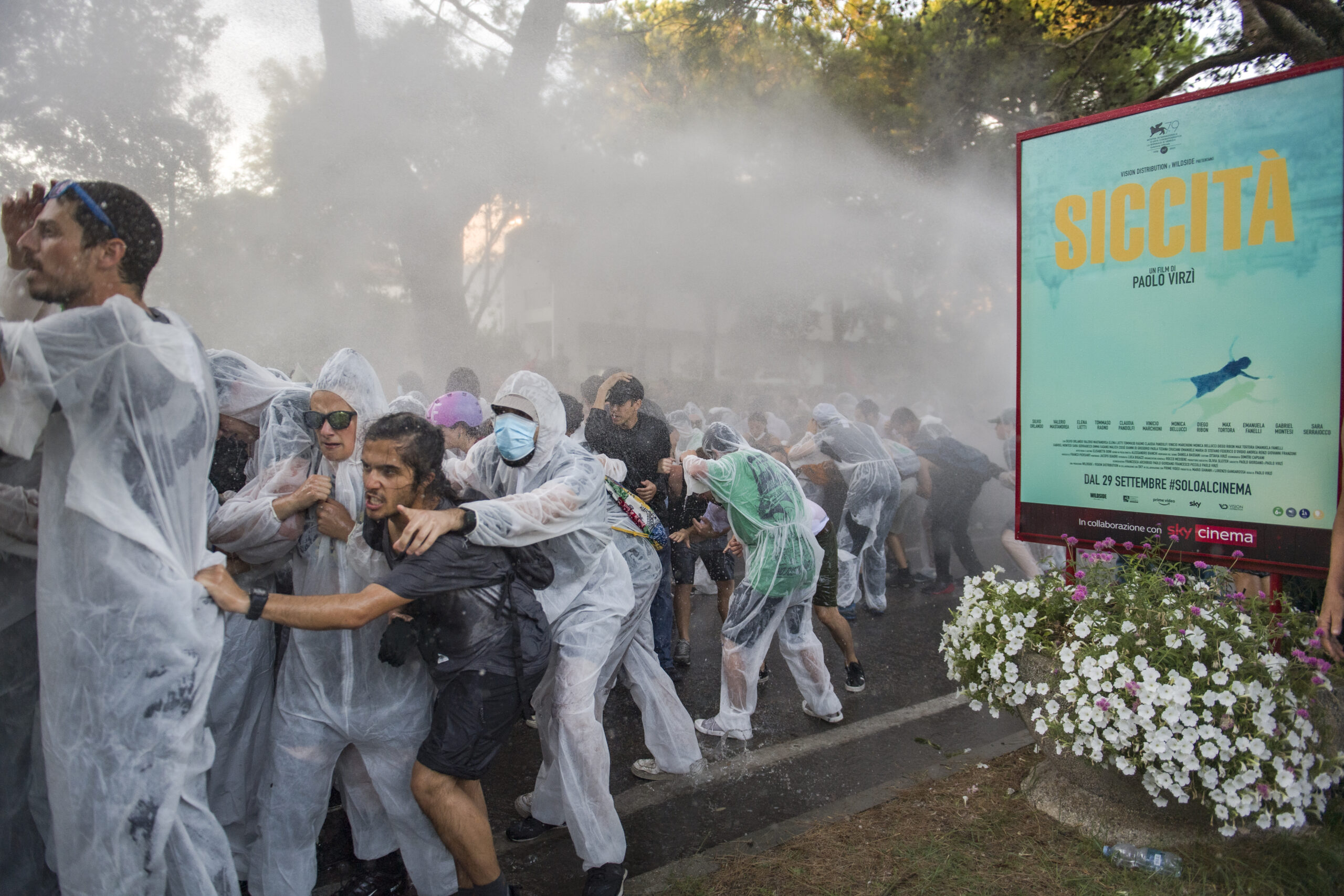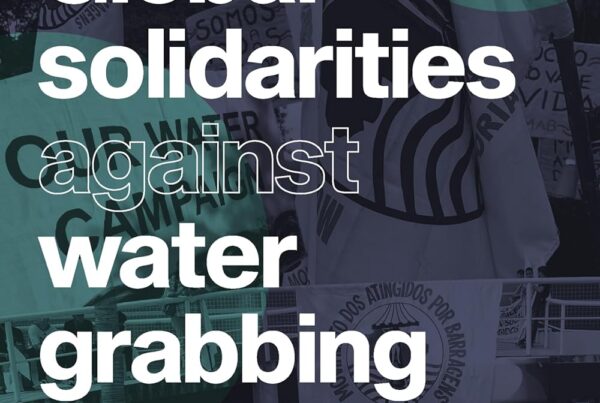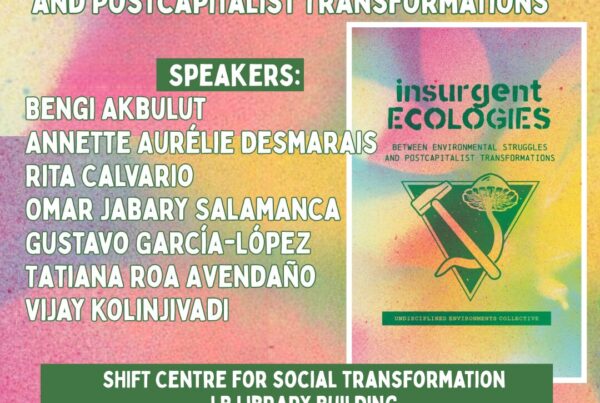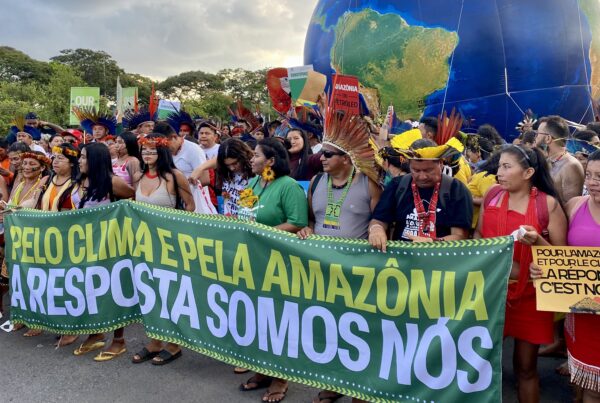by Emanuele Leonardi & Mimmo Perrotta
In this interview with Dario Salvetti, conducted on December 21, 2021 we wanted to better understand the relationship between labor mobilizations (especially the occupation at GKN) and climate justice. In practical terms, this issue started to be posed in September 2021 at the Milan Climate Camp – the radical opposition to the Pre-COP 26 where Greta Thunberg famously uttered her ‘blah blah blah’ speech – and continued, with some difficulties, during the protests against the G20-Environment meeting in Rome, on October 20, 2021. The Italian version of this interview was originally published on the website “Le parole e le cose” and in the monthly journal “Gli Asini”, n. 96, February 2022
The story of the GKN Workers’ Collective – of how it stopped an relocation project by occupying the factory and how it galvanized labor and social movements in Italy – has already been told, in English, by Francesca Gabbriellini and Giacomo Gabbuti, on Jacobin USA. Of particular relevance is the precise description of the Sustainable Mobility Public Hub proposal (soon to be pulbished by Fondazione Giangiacomo Feltrinelli).
Misunderstandings and different approaches notwithstanding, both the Italian branch of Fridays for Future (FFF) and the GKN Workers’ Collective kept framing their ‘juncture’ as strategic horizon, and finally things clicked on March 25-26, 2022: the first ‘joint appointments’ of struggles – climate strikes everywhere in Italy on Friday and the commonly organized demo in Florence on Saturday.
In terms of numbers, it was a huge success – replicated and expanded to new actors in Bologna on October 22 and Naples, on November 5, 2022. More importantly, though, is the fundamental political convergence between workers’ struggles and climate justice. Such convergence is best appreciated in the two GKN-FFF ‘joint declarations’. The first was released around mid-March last year:
“We will never again allow relocations, layoffs, precariousness to be justified with the excuse of the climate crisis. Nor will we allow a slowdown or detour in the ecological and climate transition to be justified with the defense of existing jobs. The ecological transition, if real, must also measure its effectiveness on time, and slowdown is no longer conceivable. The planet is on fire, from every point of view, and every second wasted is a crime […] A real climate, environmental, and social transition cannot disregard society’s ability to equip itself with comprehensive and eco-sustainable forms of planning. And such planning is not generated in blackmail, in the hierarchy of workplaces, in the oppression and repression of territories as has been happening for years for example in the Susa Valley [where a high-speed train has been resisted since 1991], but in the awakening of participatory and direct democracy”.
The second launched a moment of collective reflection to be held on July 26 at the Climate Social Camp in Turin:
“The reality is that climate justice cannot be achieved without touching the deepest and most dominant economic interests in society. Climate justice cannot be achieved without clashing against the dense web of economic interests at the top of society. And to achieve it, it is crucial to radically rethink the production and consumption model, which is currently based on a strong power asymmetry. Which implies, among other things: collective ownership of key sectors in order to conduct industrial policy in line with the ecological principles; necessity and sufficiency; lowering the consumption of the wealthiest, thereby protecting the weakest segments of the population, while simultaneously decreasing the climate burden of consumption of the super-rich and establishing, through redistribution, truly universal welfare measures that recognize the importance of care activities”.
The political relevance of these words cannot be underestimated, in our opinion. Hence, we think it is interesting, now that the ‘convergence’ is a political reality in Italy and that the Sustainable Mobility Public Hub proposal will soon be publicly discussed, to re-assess what Dario Salvetti, RSU [Unitary Trade Union Representative] of GKN, told us back in December 2021.
In the meantime, Qf Spa, the new owner of the GKN factory has not paid wages, both in November and December. The goal is obviously to made it impossible for workers to keep occupying. This notwithstanding, from December 1 to 11, the GKN factory collective has called for a self-managed referendum (in the Florence area) to show popular support for the “public and socially integrated facility” – an extension of the Sustainable Mobility Public Hub proposal. In a huge effort, made possible by a striking number of volunteers (800), the referendum roved to be a major success: 16.562 votes in favor of such plan for reindustrialization.
Minimal history 2022:
– March 25/26: first convergence with Fridays for Future, in Florence – 30.000 people.
– July 26: participation to the Climate Social Camp in Turin.
– October 22: second convergence with Fridays for Future, Network for Food Sovereignty Movements against mega-infrastructures, in Bologna: 30.000 people.
– November 5: third convergence with Fridays for Future, and the Neapolitan movement of the unemployed, in Naples – 20.000 people.
On Dec. 23, 2021, a new owner bought GKN in Campi Bisenzio, the automotive axle shaft factory occupied by the workers since July 9, following the announcement by the previous owner – the British investment fund Melrose – of the closure and dismissal of all employees. The arrival of a new owner is certainly an important result of the mobilization, which was primarily aimed at safeguarding jobs. However, the future of the plant remains uncertain, starting with what its production destination will be.
Minimal history 2021:
July 9: the factory is occupied.
July 24: first demo, in Campi Bisenzio (FI) – 3.000 people.
August 11: second demo, in Florence – 5.000 people.
September 18: third demo, in Florence – 40.000 people
During these months of intense mobilization, the workers’ collective, with the support of solidarity engineers and economists, has developed – and continues to develop – proposals for a new re-industrialization plan, as part of a Public Sustainable Mobility Hub. The details of the PSMH are not yet fully known. Its political significance, however, is very clear: it is about thinking the necessary environmental planning with the workers’ heads, not over them. And it is worth noting that such thinking is based on a constitutive relationship between workers’ knowledge and political ecology. The starting point is that one cannot talk about ecological transition without clearly indicating who has to bear the costs – answer: those whose investment decisions have historically produced the planetary crisis; and who decides the political direction of the transition itself – answer: the State under workers’ control.
Notwithstanding the importance of the first element, however, it is the second aspect that constitutes the greatest originality of the current struggle, linked to the motto #insorgiamo [Let’s uprise!]. Simplifying, the issue at stake is the ecological dimension of class composition: until now, environmental protection has mostly been thought of in opposition to working-class identity – especially in heavy industrial sectors. Beginning with conflicts like this, however, it becomes possible to reverse the terms of the problem: given the failure of the capitalist green economy (based on a putative compatibility between profit-making and environmental protection), only the workers’ political involvement in environmental planning can give an ecological transformation of the production structure a chance to succeed.
We discussed these issues with Dario Salvetti, RSU [Unitary Trade Union Representative] of GKN, on Dec. 21, 2021. Below is a transcript of the highlights of our meeting.
The encounter between a workers’ struggle and climate justice movements
We have always tried to be a factory that has its own opinion on how you produce, what you produce, how much you should produce. We have never had a corporatist approach to the fact that we are a factory in the automotive supply chain; in fact, we have always experienced as a contradiction the fact that we were making a product – the axle shafts – that went on luxury cars and commercial vehicles, so it belonged to a model of development that cannot be ours. We want wages, sure; but we also want a future for our children and ourselves. In addition, the fact that we have been a factory that over the years has held out on the ground of fighting precarity and fighting for our own time off, so for Saturdays, for Sundays, for keeping overtime under a certain degree of control, has meant that many of us could be active outside the plant in various forms, not necessarily militant ones, such as volunteering or teaching football to children. We have always been linked to the surrounding territory, and this for example has also meant our participation in the mobilization against the waste-to-energy plant, which has always been very heartfelt. So even though we knew that we were starting from a very unfavorable terrain – because it is clear that when you are a wage earner who has to organize along union lines, and who has to think first of all about wages and labor rights, and it is clear that it is not on strictly factory ground that you can question the world to which the factory belongs – yet we have always had an interest about ecology.
Then it happened that the environmental issue paradoxically assumed centrality in the narrative of our class opponent – the bosses. So, willingly or unwillingly, we had to come to terms with that narrative. If the automotive sector is facing a social massacre – because we are talking about 300,000 jobs being cut across Europe, 50-60,000 of which are at risk in Italy alone and 5,000 in Tuscany – this is happening on the basis of a putative ecological transition. This narrative tells us that our layoffs are necessary to protect the environment: in Il Sole 24 Ore [the broadsheet of Confindustria, the association of Italian industrial entrepreneurs] a few days after we were laid off, an article came out which basically said “you wanted Greta and now you get layoffs.” So, we had to question whether that narrative was correct or not. In fact, if they said to me, “sign your dismissal and give your daughter a cleaner future,” I would seriously think about it, because I would rather get any other job if a truly cleaner world was on the offer.
In our case, however, this narrative is not true, first of all because the product we make also goes on electric vehicles. At the European level, the need for axle shafts is increasing, because electric cars actually need more axle shafts than some endothermic cars that only have them on the front end. So, once we realized that this narrative was at the very least instrumental, we had to start looking for support in mobilization networks linked to political ecology, looking for groups that were willing first to dismantle that narrative and then – when we found ourselves being fired – to be part of our struggle.
Then there was another reason for meeting with ecological movements, more linked to the actual building of social conflict. All the great cycles of historical mobilization have coincided with a general effervescence in society, which feeds into workers’ conflict – and vice versa. When we found ourselves jobless, that July 9, we reacted by bringing 40,000 people to the streets of Florence on September 18. But a few days after we saw the mobilization around the pre-COP in Milan, with 50,000 people taking to the streets for climate justice. And then we attended the Climate Camp, and we said to ourselves, “these two movements need to add up and push the country toward a general, generalized strike.” This has only partially succeeded at the moment, but we continue to think that this is the way.
For now we are at coincidence, we are not yet at convergence, in the sense that there is a mutual will to build something together, but currently this coincides only sometimes, on given moments, in specific situations, but convergence is something more: it is when my plan of struggle already puts into account that it has to merge with yours and therefore my deadlines are already yours and we try to make our agendas coinciding. After the September 18 demonstration, unfortunately this convergence has been very laborious, first because in reality not everyone has fully grasped how vital this element is, and second because we are all victims of fragmentation.
Now we would still like to relaunch the Sustainable Mobility Public Hub proposal regardless of the events of the dispute related to the closure of our factory. Right now, a private individual has bought GKN Florence, stating that he will probably sell us back to a company that makes machines for pharmaceuticals, so we would produce something completely different, moreover not with this machinery, which will be taken away behind the promise that more are brought in, with a social effort that is absolutely unnecessary. And it just so happens that the owner coming in is someone who claims to make the circular economy, the green economy, his guiding star. So, whether we like it or not, it is the class opponent who brings the environmental issue directly into our discussions. We are a company that comes from automotive, we are a former-FIAT, and the idea of the Sustainable Mobility Public Hub continues to interest us, we are going to try it all the way through.
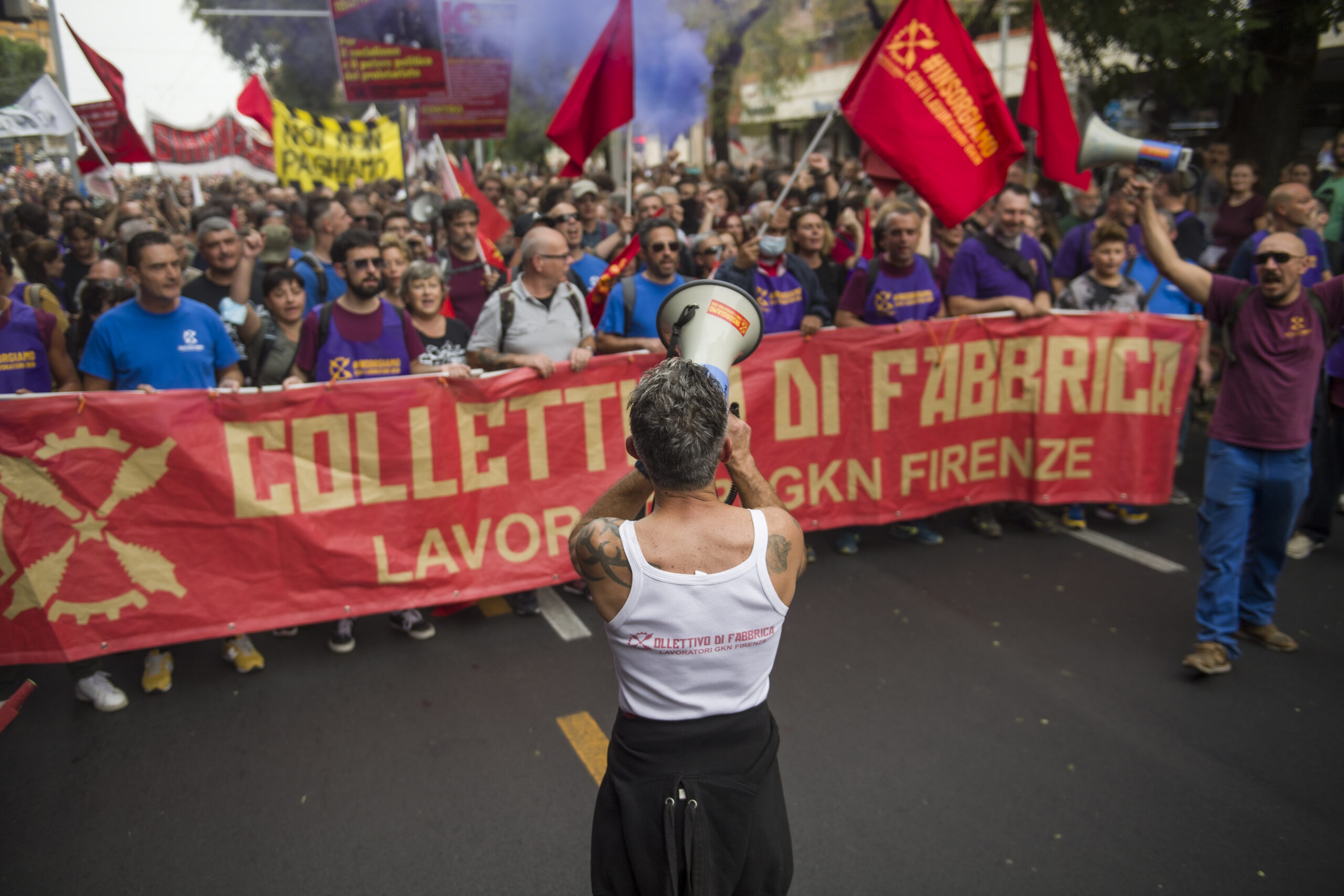
Convergere per Insorgere, manifestazione 22/10/2022, Bologna. Credits: Michele Lapini
The contradictions of wage labour
From that 9 July, first of all we claimed to be employed and work in the very same conditions in which we were previously employed. However, since that balance had been broken – we found ourselves to directly manage the plant for several months –, and due to the strength of the mobilization around us, we were pushed to also discuss what we would like this factory to be producing, and how. Moreover, in our opinion the relationship between production and the environment is very complex: we think that the idea of the compatibility between private capital valorization and the environment should be seriously questioned, even if you produce components for green hydrogen buses. Sure, it is preferable to produce axle shafts for green hydrogen buses than for big diesel jeeps; however, the private capital valorization itself brings you to use the energy, efforts, and research, in a direction that probably leads to environmental waste, regardless of the product you make.
Just to give you an example: from the union point of view, if there is a night shift, I – as RSU – negotiate the pay increase for night shifts; in this plant we achieved excellent increases, from the union point of view, but they brought to the contradiction that some workers want to permanently work the night shift, because otherwise they can’t make ends meet. But if you ask me whether it is normal that a human being spends the night awake, in the factory, or if the night shift is healthy, well, I answer that it isn’t healthy and that in a different society nobody should work the night shift and produce axle shafts, not even for the greenest bus in the world. Moreover, it is a scandal that at night you find workers that make axle shafts but probably you don’t find the staff at the emergency room in public hospitals.
This is true for environmental issues, too. We are kept within a mechanism in which we cannot decide what we produce. So, in our experience there is first the defense of wage labor as such, a job that does not have the opportunity – in this society – to take responsibility for what it produces. Then there is the wage labor that would like to be made responsible for what it produces. Finally, there is wage labor which acknowledges that many of the things it does are wrong anyway.
Another example: in this plant, we have robots that save you from some ergonomic movements: they represent an improvement, because, in theory, they save you from some physical efforts. However, these robots are designed with the aim of reducing the cycle-time for the production of an axle shaft by one second. Here, as in the industrial process as a whole, your aim is to reduce the time needed. How long does the production cycle last on the machinery? 22 seconds? Your goal is to get to 21 seconds. But is it right for humanity to use research, time, matter, energy, to reduce the cycle-time by one second, as in this case? And then, what for? To give me the day off or to produce more and more?
Environmental issue, more than other topics, allow us to go all the way in this argument, which is a systemic one. Let’s talk about offshoring. Here, they will further relocate the production, but it has already been widely offshored. For our axle shaft, components arrive from all over Europe (except for one component, which is produced in our plant): we assemble it here, and then the axle shaft is moved to Melfi [a small town in Southern Italy, where one of the largest Italian automotive industrial complexes is located], where a car with 20,000 components is produced, and each component is produced with materials that come from all over the world, and then that car is picked and sent to the US. When you face this systemic mechanism, how can you really talk about zero emissions? There is so much possibility of energy and social saving, upstream, even before asking – and then of course I ask myself! – what the exhaust pipe throws out.
A generative conflict
Obviously, this is not a militant reality, this is not a political party, this is not a trade union, this is a factory. 400 people, that, moreover, used to have totally different roles within it: some were bosses, some were boss to bosses, some were technicians, some were assembly workers like me, and so on. Anyway, the first reaction of everybody was extremely positive. Of course, the level of consciousness of the RSU, the factory council, is not the same as the whole working collective and the rest of the assembly; nonetheless, our message has never been contested within the factory, it has remained widely accepted, some out of trust, some out of participation, some out of sympathy, and it is something that usually doesn’t happen. The element that significantly changed the struggle is the fact that there is a world around this factory, a world that was there even before the layoffs, and we – as union delegates, RSU, factory council, workers’ collective – had built a connection with this world, we kept this connection, that the rest of the factory sometimes understood, sometimes not, and sometimes just tolerated.
These months of occupation changed everybody – someone more than others. We had always prepared ourselves for the possibility of the closure of the factory and we introjected concepts such as machinery control, and don’t let the machinery go out of the factory, thus potentially occupy the factory, too. All this in the context of a strong union confrontation. We had all this inside us, we had generalized these ideas within the factory, even before July the 9th. Then, over the following months, many other things have become mature: we stimulated the government, by submitting a bill proposal [to regulate industrial relocation], we overtly talked about nationalization (under workers’ control), we felt the need of an industrial plan of ours, and, thus, we proposed how we would like to organize the entire society. An idea produces a balance of forces, a balance of forces produces an idea, an idea produces a balance of forces. If on 9 July we were able only to organize a demonstration between the two roundabouts out here, when we overcame that gate a mobilization took place and it made possible that those ideas you deemed impossible, now seem the only desirable ones. Now a new owner arrives and says “I will save you”, and many workers grumble and say: “I wanted the nationalization of the factory, under workers’ control”. But we haven’t lost, because by now we kept the jobs; we need a different balance of forces to take a step further.
Concerning the technicians: ours made themselves available to support our research, our suggestions, the elaborations we asked them, even if they weren’t autonomous in their elaboration on these points. The true relationship with technicians was with both the researchers of the Sant’Anna School of Pisa and the group of solidary engineers, as well as with the Network of Italian Workers’ Buyouts: they come from outside the factory, and they made themselves available as a network of skills for us. If we ever resume production with an industrial plan of ours, we will find the necessary supportive skills there.
Trade unions and environmental issues
Within our trade union – Fiom-Cgil [the main Italian metalworkers’ union] – we had no quarrels on environmental issues, because, unfortunately, these topics are not discussed enough. We are all satisfied with some slogans, which we agree upon, for sure, but they represent just catch-phrases. Nowadays, the idea that environment and labour must not be in contradiction with each other is commonsensical for every trade union, except for the most boorish organizations; but we never discuss what this exactly means and how it must be defended day by day. Environmental issues are the same as talking about peace in the world: in principle everybody agrees but, after that, the struggle against the war is much more complex. There aren’t quarrels because there aren’t points of discussion. Landini [the national leader of the Cgil Union] met Greta Thunberg and appointed her as honorary member of the union, but everything stopped there. Of course, we are talking about big unions, for sure someone realized important works on environmental issues, and probably I don’t know them, but they aren’t yet part of the common heritage of our organization.
For as far as the Italian automotive production is concerned, the problem is that the main corporation – first FIAT, then FCA, now Stellantis – decided that Italy is not a country for the mass production of cars. And this doesn’t change if you move to electric vehicles. You can produce electric vehicles in either Italy or Poland, everywhere. The issue is: what is the balance of forces inside Stellantis, to impose that the production is done with a certain level of rights. The workers of the company are at the mercy of what Stellantis – once FCA – decides.
I don’t think that currently there is a clarity of judgment, among automotive workers, about the electric car. There is the hope that sooner or later production volumes will grow again, because, if they really think to radically substitute all the circulating vehicles, at a certain point there will be a lot of work for everybody. But it is not true. Probably many workers don’t believe the idea that the electric car will bring them back to sufficient production volumes that allow their plants to survive. And probably I don’t believe it as well. And I repeat it, we are puzzled by the very concept of electric mobility. Yet, we are no engineers. Now the electric car seems a way to bring back in vogue nuclear energy, on the one hand for the electric power in the grid, that should be used to charge electric cars, and on the other for the issue of raw materials that are needed. And, finally, there is the problem of the old vehicles as waste to be treated.
Sustainable mobility and green hydrogen: the elaboration of a new industrial plan
In the elaboration of an industrial plan of ours, we firstly elaborated the proposal to produce axle shafts for electric buses, in a network with other plants, and in the context of a direct engagement of the State for sustainable mobility. Moreover, we discussed the issue of green hydrogen. We don’t want to accidentally end up doing greenwashing; hence we just advance some hypotheses. The idea of green hydrogen come from the observation of some contradictions. Close to us, in the small town of Pontedera, in 2007, under a public patent, the first ammonia-fueled car was produced. To be precise, it was not a car, but a van for garbage collection and it was zero emission, because in that case the hydrogen is produced from ammonia. Thus, we asked: “excuse us, do these projects, this green hydrogen supply chain you want to build, exist, or not? If it exists, can we examine the relative documents and study what is still missing to start, and if it is truly green or is it only an advertisement? If it is just advertisement, we want to publicly denunciate it, and stop talking about it. If, instead, there is something to elaborate, we are here.” In the automotive sector in the Tuscany region around 5,000 jobs are at risk. Thus, our idea is to create a supply chain of green hydrogen, with the start-up projects that exist in the area of Pontedera, that are all connected to the university; hence, starting from public patents, we proposed to build a supply chain that could re-employ these workers and produce green buses, ships and trains. There are projects, money, and announcements – it was said, for example, that the railway line between Florence and the city of Faenza can be powered by hydrogen – but by now these are just announcements.


